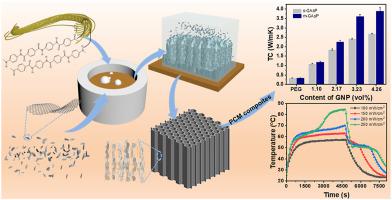Materials Today Physics ( IF 10.0 ) Pub Date : 2022-08-08 , DOI: 10.1016/j.mtphys.2022.100811 Jin Gao , Gaojie Han , Jianzhou Song , Chengen He , Ji Hu , Wanhui Wang , Yuezhan Feng , Chuntai Liu

|
Three-dimensional (3D) graphene skeletons show the high potential using in encapsulation of phase change materials (PCM), yet still suffer from the high contact thermal resistance between graphene sheets in skeleton. In this work, aramid nanofiber (ANF) with high molecular chain orientation and rigid conjugate aromatic structure was firstly used to assemble graphene nanoplates (GNP) into a 3D thermally conductive skeleton. Typically, ball-milling treatment was used to improve the interfacial interaction between ANF and GNP, followed by unidirectional freezing technique was used to achieve 3D ANF/GNP skeleton with highly oriented honeycomb-like porous structure. As an encapsulation for PCM, ANF/GNP skeleton not only provides the thermal conduction path, but also endows excellent solar-thermal conversion ability, which greatly expands the application in solar energy utilization. Thus, the thermal conductivity of PCM composite can reach to 3.9 W/mK at only 4.26 vol% of GNP content, which gives the composite with rapid and stable heat charging/discharging ability during phase change process. Moreover, the honeycomb channel structure of ANF/GNP skeleton with huge capillary and surface tension forces not only reinforce the shape stability during phase change process, but also accommodate sufficient PCM for energy storage. Therefore, this work demonstrates the high-efficiency of ANF in constructing 3D thermally conductive graphene skeleton, which reveals a high potential using in encapsulating PCM.
中文翻译:

1D芳纶纳米纤维/2D石墨烯定制3D导热骨架用于高性能相变复合材料,具有优异的太阳能热转换能力
三维 (3D) 石墨烯骨架显示出在相变材料 (PCM) 封装中的高潜力,但仍然受到骨架中石墨烯片之间的高接触热阻的影响。在这项工作中,具有高分子链取向和刚性共轭芳族结构的芳纶纳米纤维(ANF)首次被用于将石墨烯纳米板(GNP)组装成3D导热骨架。通常,球磨处理用于改善 ANF 和 GNP 之间的界面相互作用,然后使用单向冷冻技术获得具有高度定向蜂窝状多孔结构的 3D ANF/GNP 骨架。ANF/GNP骨架作为PCM的封装,不仅提供了热传导路径,还赋予了优异的光热转换能力,极大地拓展了在太阳能利用中的应用。因此,在 GNP 含量仅为 4.26 vol% 的情况下,PCM 复合材料的热导率可以达到 3.9 W/mK,这使得复合材料在相变过程中具有快速稳定的充放电能力。此外,ANF/GNP骨架的蜂窝通道结构具有巨大的毛细管力和表面张力,不仅增强了相变过程中的形状稳定性,还可以容纳足够的PCM进行储能。因此,这项工作证明了 ANF 在构建 3D 导热石墨烯骨架方面的高效性,这表明在封装 PCM 方面具有很高的潜力。这使复合材料在相变过程中具有快速稳定的充放电能力。此外,ANF/GNP骨架的蜂窝通道结构具有巨大的毛细管力和表面张力,不仅增强了相变过程中的形状稳定性,还可以容纳足够的PCM进行储能。因此,这项工作证明了 ANF 在构建 3D 导热石墨烯骨架方面的高效性,这表明在封装 PCM 方面具有很高的潜力。这使复合材料在相变过程中具有快速稳定的充放电能力。此外,ANF/GNP骨架的蜂窝通道结构具有巨大的毛细管力和表面张力,不仅增强了相变过程中的形状稳定性,还可以容纳足够的PCM进行储能。因此,这项工作证明了 ANF 在构建 3D 导热石墨烯骨架方面的高效性,这表明在封装 PCM 方面具有很高的潜力。











































 京公网安备 11010802027423号
京公网安备 11010802027423号